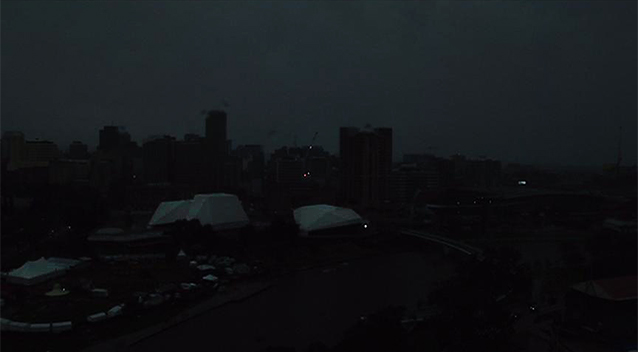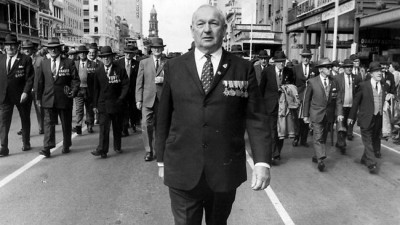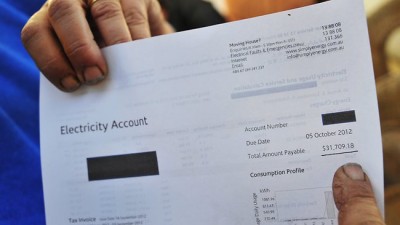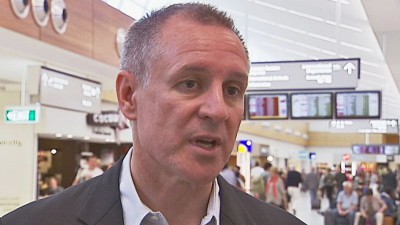
***
In the 1940s, South Australian Legend, Tom Playford (Premier for 26 years from 1938 to 1965) took a natural gift, in the form of vast untapped reserves of brown coal located at Leigh Creek, directed it through power plants at Port Augusta and, with its cheap and reliable power supply, built a mining, manufacturing and industrial power house: from 1946 to 1965, the proportion of South Australians connected to electricity increased from 70% to 96%; and over that time the population almost doubled from around 600,000 prior to WWII to over 1.1 million when he hung up his political gloves in 1965 (see our post here).
Fifty years on, how times have changed.
Isolated, parochial and run by morally bankrupt idiots, South Australia is at a crossroads: its hapless Labor government – utterly obsessed with wind power – is incapable of making even the most basic of political decisions; and even less capable of persuading a constituency – with the highest unemployment in the Nation by a country mile – that creating jobs, income and wealth require infantile, ‘feel-good’ ideology to be sacrificed at the altar of pragmatism, every so often, for the benefit of all.
One such example, is the complete botch its vapid Premier, Jay Weatherill made of a long-heralded move to set up a nuclear waste handling and storage facility in SA (Australia is one of the world’s leading uranium exporters; South Australia is home to two of Australia’s three uranium mines: Olympic Dam and Beverley).
After a Royal Commission (arguably necessary?) delivered reasons in support of the proposed facility, Weatherill was crippled with fear that the lunatic Green-Left would burn him at the stake, if he simply decided to follow the Commission’s recommendations.
Instead of making a decision, and selling it, Weatherill flubbed it: anointing a “Citizens Jury” with the task of determining South Australia’s economic future. The Jury were beguiled by a circulating parade of neo-Marxist, anti-Nuke, Greens (watermelons like Green MLC, Mark Parnell) into believing that South Australia would soon become the setting for a real-life remake of ‘The China Syndrome’.
Pelted with propaganda and baffled with BS, unsurprisingly, by a majority the Jury came out against nuclear power, in general, and the proposed waste facility, in particular.
Confirming just what a farce the Citizens Jury process was, South Australia’s Sunday Mail ran its own survey, which came to completely different conclusions.
Not only are a majority of South Australians keen to tap into an atomic future, the same proletariat who were (as Clean Energy Council surveys purred) once ready to hug these things at every opportunity, have turned on wind power with a vengeance.
No doubt with their minds focused – after the worst blackout in South Australian history (Black Wednesday, 28 September) – a huge number of South Australians now rank power pricing and the reliability of their power supply as the most important issue in their lives.
Not so long ago, very few South Australians would have expressed a favourable view of nuclear power: now over 56% support the nuclear industry and close to 40% believe that the only way forward is to build nuclear power plants, capable of delivering secure, reliable and affordable power for generations to come.
Here are several of the pieces that appeared in last week’s Sunday Mail, which make it very clear just how far out-of-favour wind power has fallen; and precisely where South Australians want their all-too-timid political betters to lead them.
SA SPEAKS: Price hikes add to our distress
Sunday Mail
Miles Kemp
20 November 2016
LIVING COSTS
THE cost of living remains one of the biggest issues for South Australians as bad growing conditions for farmers and the annual electricity price hike have driven up costs in the state.
More than one-third of survey respondents said cost-of-living pressures were one of the biggest issues facing the state.
This makes it the third most concerning subject behind jobs and job security, and power supply and pricing issues.
Last year, 54 per cent of respondents nominated cost of living as one of the biggest issues facing SA.
The findings come as figures from the South Australian Council for Social Service show the worst quarterly cost-of-living increase.
Overall price increases meant for the quarter age pensioners faced a cost of living increase of 1.5 per cent, and other social security recipients 1.6 per cent, well above CPI of 1.3 per cent.
Fruit prices increased by 23.8 per cent and vegetables by 8.5 per cent. The organisation’s report – released to the Sunday Mail to coincide with its own survey – found: “The main drivers of the cost of living rise in the last quarter were food and electricity prices.
“Food price increases were driven by fruit and vegetable prices which skyrocketed due to adverse weather conditions in major growing areas, while electricity prices jumped with yearly price increases on July 1, 2016.” SACOSS chief executive Ross Womersley said even small cost-of-living pressures highlighted in the report, when repeated many times over as they had been, translated to real financial hardship for many pensioners and families.
“For those whose only source of income is a base-rate age pension and who spend all their income, the cost of living over the last year increased by $6.50 per week, while their income only rose by $5.05 – so they are $1.45 a week worse off than a year ago,’’ he said.“Similarly, for a single person on the base rate of Newstart with two children, their cost of living last year went up by $8.82 per week while their income increased by only $7.21, leaving them $1.65 a week worse off.’’
Sunday Mail
SA SPEAKS: So, did the citizens’ jury get it wrong?
Sunday Mail
Paul Starick
20 November 2016
Poll says the majority in favour of SA nuclear industry
MAJORITY support for creating a nuclear industry in South Australia is revealed in an extensive Sunday Mail survey of public opinion, in a rebuff to moves to shut down further study of a high-level waste dump.
The 4000 respondents to the annual Your Say, SA survey ranked nuclear among the top six most important industries to the state economy over the next 20 years.
More than 56 per cent supported moves to create a nuclear industry in SA but 43.7 per cent were opposed.
Asked what nuclear facility SA should build, 39.6 per cent said a nuclear power plant, 39.7 per cent wanted a repository for Australian radioactive waste and 34.9 per cent backed the high-level repository controversially proposed by the nuclear royal commission.
The results lend weight to Treasurer Tom Koutsantonis’s claim of a “silent majority” in favour of Labor’s proposed referendum on the nuclear fuel cycle.
They cast doubt over a citizens’ jury’s blanket rejection this month of “participation any further in the nuclear cycle, specifically foreign high-level nuclear waste storage facility” as “detrimental to our image”.
Support for nuclear power generation appears to have been bolstered by 56.4 per cent of respondents declaring power supply and prices the biggest issue facing SA, second only to 63.1 per cent saying jobs and job security.
Premier Jay Weatherill told the Sunday Mail the $257 billion projected revenue from a repository for overseas waste showed the opportunity should be fully explored, not prematurely dropped because of political opportunism. But Opposition Leader Steven Marshall said worries about job security and high power prices showed South Australians had no confidence in Labor, which wanted to gamble $600 million of public money on trying to attract the world’s high-level nuclear waste.
The survey results suggest people are open to further debate, despite 39 per cent saying the state should not build a nuclear facility of any kind and a dump for international waste attracting 35 per cent, rather than majority, support.
This contrasts with two-thirds of the 350-person citizens’ jury declaring it did not want to pursue the high-level dump under any circumstances, even though its report did highlight “involvement in nuclear waste disposal may lead to nuclear power becoming a feasible alternate power source”.
Two Advertiser/Galaxy polls, in February and September, have uncovered 48 per cent and 49 per cent support respectively for the high-level waste repository. In the September poll, 61 per cent of Liberal supporters were in favour, although Mr Marshall withdrew bipartisan support for exploring the opportunity only this month.
The Your Say, SA survey also found more than 58 per cent were pessimistic about the state’s future, while 35.5 per cent were somewhat optimistic and just 6.1 per cent very optimistic.
Two-thirds thought life for their children or grandchildren would be more difficult and stressful.
Mr Weatherill recommitted to a referendum on the high-level dump, saying it was ultimately a matter for people, not political parties, to decide.
“I believe the only way forward is the restoration of bipartisanship, then we must put our trust in the people of South Australia through a statewide referendum,” he said.
He said diverse views on the nuclear issue also had been uncovered in statewide consultation.
Mr Marshall said the survey results confirmed people did not have any confidence in the Labor government.
“This is consistent with what people are telling me across the state. People are worried about keeping their jobs and they’re worried about their children finding a job,” he said.
“South Australians are being punished by ridiculous power prices and State Government charges.” The Your Say, SA survey results show a slight decline in support for a nuclear industry in SA since last year, when 65 per cent of more than 5700 respondents declared support and 35 per cent were opposed.
Importantly, support for an international waste repository was almost identical, at 34 per cent, while 47 per cent supported a nuclear power plant and 43 per cent backed a national waste dump.
The centrepiece recommendation of the Nuclear Fuel Cycle Royal Commission, which reported in May, was that SA investigate the feasibility of storage and disposal of international used nuclear fuel and intermediate-level waste.
Analysis prepared for the royal commission determined, on conservative estimates, this repository could generate $257 billion in total revenue, with costs of $145 billion over the project’s 120-year life.
But Mr Weatherill decided against policy or legislative change “at this time” in the wake of the citizens’ jury report, released on November 6.
Sunday Mail

now despised by all but the corrupt and ignorant.
***
SA SPEAKS: What you said about Wind farms
“As proved recently, they do not have the capacity to support the state’s requirements. All subsidies should cease and some coal-fired power stations be reopened.”
“They can’t operate if it is too windy and do not provide base-load power.”
“I have no concern re visual amenity but wind farms alone will not be enough to provide reliable power supply.”
“They produce too much greenhouse gas to be manufactured and installed.”
“Wind farms are a blight on the landscape. They kill birds and have created health problems for those living nearby. Disgusting things!”
“The government needs to now invest in storage of power to ensure supply when the wind farms are unable to operate. We are too reliant on renewable sources.”
“The noise created by wind farms may do damage.”
Sunday Mail
SA’s dilly-dallier-in-Chief, Jay Weatherill: crippled by indecision.
***
Stop the dilly-dally, Jay, and DO IT!
Sunday Mail
Chris Kenny
20 November 2016
SOUTH Australia would not exist in its current form if our forebears were as hopeless at making decisions as we are right now.
When Edward Gibbon Wakefield decided he wanted to establish a colony based on free enterprise, there would have been a series of parliamentary inquiries in Britain, a royal commission, a citizens’ jury, a mission to consult the various indigenous nations inhabiting this part of the continent and an environmental-impact statement outsourced to a firm of consultants that would have turned the contract into a three-year holiday at what is now Victor Harbor.
The EIS would have identified clear threats. Trees would have to be cleared on the plains to build the first settlement and the River Torrens would soon be dammed to provide permanent water. This would have damaged the wetlands around Henley and West Lakes.
Roads might be cut through the hills, exotic trees planted and, perhaps, grapevines introduced to the Barossa Valley and McLaren Vale areas.
The consultants would have worried about millions of hectares of mallee given over to wheat, barley and sheep, and there would have been fears that, eventually, some vandals would dig drainage networks in the South-East to turn swamps into lush grazing land.
They would have warned about copper mines on Yorke Peninsula and foreseen sporting fields on the banks of the Torrens – who knows, some futurist might have imagined electricity and worried we’d eventually want grandstands and light towers.
With all these fears and complications laid out, the government in Westminster would have told Wakefield and his South Australia Company investors that they would not support his venture. They would have scrapped their proposed legislation and he would have been forced to abandon his plans; SA would be wilderness and Adelaide might have been built in South America, instead.
Thankfully, that didn’t happen and here we are – a state where we have had royal commissions into light towers and how so-called secret women’s business was used to block a bridge.
It must be at least 20 years ago that Adelaide journalists, including me, first reported on serious bids to build a high-level nuclear waste dump in SA.
To see the current political argy-bargy on this issue is to watch a political system incapable of making a decision.
For the Liberals, it is an easy oppositionist game – blocking a nuclear waste dump is as difficult as attacking the tax collector or knocking over the Australian top order.
Steven Marshall doesn’t have to worry about the lost economic opportunity or the detailed arguments. He can just ride the populist wave – like Nick Xenophon opposing free trade or the Greens lamenting the weather – and make life even tougher for Jay Weatherill.
But the Premier has bungled this. Admirably bold to start the nuclear debate, and probably wise to hold the royal commission, he then needed to decide what was in the state’s best interests and get on with it.
The citizens’ jury was always a joke – an abrogation of responsibility – and, as if that wasn’t clear earlier, it is obvious now because Weatherill wants a referendum. This is not a conscience issue, or even a complex one. Just make the call and go ahead with the dump.
This state has a long nuclear history; it is more than a century since Sir Douglas Mawson identified radioactivity in ore from Radium Hill and some of the uranium mined there was used in European research by Ernest Rutherford and Marie Curie.
Almost half a century later, SA was the site of British nuclear tests. The Federal Government passed the Defence (Special Undertakings) Act in 1952 and, in Cold War secrecy, bombs were exploded at Maralinga.
Radium Hill and Maralinga are highly controversial because Aborigines were dispossessed and workers suffered from radiation exposure – too much secrecy and not enough care.
Perhaps that colours attitudes now, with endless consultation and obsessive procrastination about a storage proposal that is a safe and low-risk operation. We know there are large quantities of nuclear waste around the world that needs to be stored for extended periods.
We ought to ask ourselves whether there is a more secure and responsible political environment than this country, or a more remote, vast and geologically stable region than the SA Outback, in which to store this waste.
The answer is obvious. So we should embrace the opportunity to provide this service to the world at the appropriate price. It need not define the state, nor limit other opportunities. But it is an industry worth embracing.
Weatherill wants everyone to support him before he acts. He should lead and get it done.
Sunday Mail




Go the whole hog and have a reprocessing facility next to the reactor. Not only would other nations pay you a premium price to take their waste, you promptly use that ‘waste’ to power your own reactors.
Have your power plants make money as opposed to throwing cash away subsidising a fart powered boondoggle.
The so called jury was self selected. No wonder it came up with a predictable verdict.
Hi,
I started a PETITION “SA PREMIER JAY WEATHERILL : Demand the RESIGNATION of the Energy Minister for HIGH POWER PRICES CAUSING SA’s JOBS CRISIS and 15,000 household POWER DISCONNECTIONS, frequent POWER BLACKOUTS and the JULY 2016 POWER CRISIS” and wanted to see if you could help by adding your name.
Our goal is to reach 100 signatures and we need more support.
You can read more and sign the petition here:
https://www.change.org/p/sa-premier-jay-weatherill-demand-the-resignation-of-the-energy-minister-for-high-power-prices-causing-sa-s-jobs-crisis-and-also-15-000-household-power-disconnections-frequent-power-blackouts-and-the-july-2016-power-crisis?recruiter=135406845&utm_source=share_petition&utm_medium=email&utm_campaign=share_email_responsive
Please share this petition with anyone you think may be interested in signing it.
Thankyou for your time.
Hi,
I started a PETITION “SA PREMIER JAY WEATHERILL : Demand the RESIGNATION of the Energy Minister for HIGH POWER PRICES CAUSING SA’s JOBS CRISIS and 15,000 household POWER DISCONNECTIONS, frequent POWER BLACKOUTS and the JULY 2016 POWER CRISIS” and wanted to see if you could help by adding your name.
Our goal is to reach 100 signatures and we need more support.
You can read more and sign the petition here:
https://www.change.org/p/sa-premier-jay-weatherill-demand-the-resignation-of-the-energy-minister-for-high-power-prices-causing-sa-s-jobs-crisis-and-also-15-000-household-power-disconnections-frequent-power-blackouts-and-the-july-2016-power-crisis?recruiter=135406845&utm_source=share_petition&utm_medium=email&utm_campaign=share_email_responsive
Please share this petition with anyone you think may be interested in signing it.
Thankyou for your time.
We should have had a nuclear power industry 50 years ago, instead of all these stupid windmills, started by ex premier Mike Rann wanting SA to be the renewable energy capital of Australia….Rann and Weatherill are raving lunatics.
In Victoria I don’t think there has been one complaint on Origin’s Mortlake gas power plant. As for AGL’s Macarthur wind factory, there have been thousands. Nuclear power or cleaner coal means more long-term jobs, than noisy, intermittent fully subsidised wind factories.
Time to take the negative nuclear events of the past and turn them into a positive to create clean base load electricity for all.
How many other industries can offer long term jobs for the next 60 years?